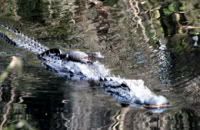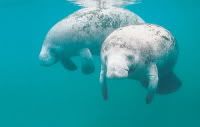"it's all connected" 
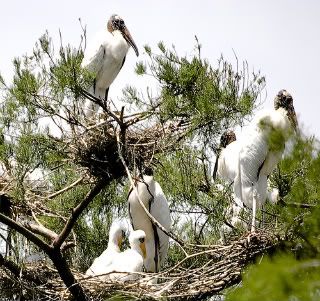
Endangered wood storks nesting in Fred George Basin, Leon County.
Environmental groups achieve wetland protections in settlement of two lawsuits near Corkscrew Swamp Sanctuary
By Aislinn Maestas
National Wildlife Federation
A coalition of five environmental groups, including National Wildlife Federation and Florida Wildlife Federation, has settled two lawsuits in exchange for significantly increased wetland and habitat protections. The coalition has been opposing several proposed residential and golf projects in the ecologically important Cocohatchee Slough near Corkscrew Swamp Sanctuary in Florida.
After over four years of litigation and several iterations of project permits, the environmental coalition and developer G.L. Homes of Sunrise, Florida, have agreed to over 200 additional acres of wetland impact reductions, restoration of endangered wood stork habitat, and relocation of Logan Boulevard onto old farm fields instead of through wetlands. This is in addition to $3 million of additional offsite mitigation secured in previous litigation on Saturnia Falls. Joining NWF and FWF in this victory are Audubon of Florida, Collier County Audubon Society, and Conservancy of Southwest Florida.
The settlement of these two federal lawsuits was preceded by other coalition legal actions at the state level challenging impacts to downstream water quality, flood protection and aquifer recharge, in addition to wetland and wildlife harm. All these water resource factors will benefit greatly from the significantly increased levels of wetland protection and restoration in this settlement.
In addition to these very positive results for wood storks and other imperiled species plus water resources, the same environmental coalition had earlier in October 2009 won a federal lawsuit against another residential golf course project called Mirasol which would destroy over 600 acres of unique wetlands in the same Cocohatchee Slough which emanates from Corkscrew Swamp. That is well over twice the acreage of wetlands destroyed on Parklands Collier and Saturnia Falls combined. In that decision a Southern District Court judge revoked Mirasol’s permit based on complaints over illegal wetland and wildlife impacts.
Jan Goldman-Carter, Water Resources Counsel for National Wildlife Federation, observed, “The revocation of the Mirasol permit offers another opportunity for the Army Corps and the South Florida Water Management District to require the avoidance of additional wetland, water and habitat impacts, additional protection, and true habitat restoration on the Mirasol site.”
Mirasol’s destruction of wetlands, combined with other wetland losses in the region, would have devastating effects on the wood stork nesting colonies at Corkscrew Swamp, the largest in the nation and vital to the species’ recovery. This cumulative destruction would also harm downstream water quality, flood protection, and water supply for the region.
Looking for opportunities to prevent further destruction of wetlands and habitat, the environmental groups are also working with state and federal agencies to improve the way they permit and compensate for wetland losses incurred when development is sited in Florida wetlands. Recommendations currently under consideration could significantly reduce or eliminate such impacts before the projects end up in court, wasting time and money, or worse, getting built and irrevocably destroying habitat for declining wildlife throughout Florida and harming the public’s interest in protection of vital water resources.
Wildwood Preservation Society is a non-profit 501(c)(4) project of the Advocacy Consortium for the Common Good. Click here to learn more.
Saturday, July 10, 2010
Good news for Wood Storks in South Florida!
Tuesday, June 23, 2009
Greedy developers seek to weaken endangered wood stork protections

Ed. Note: The efforts described in the articles below by builder groups and deep-pocketed developers to weaken protections for endangered wood storks amount to nothing more than a charade of misinformation based on pure greed, plain and simple. The builders cite 2006 nesting numbers and point to the big rebound in wood stork nesting this year. However, they fail to mention the fact that during 2007 and 2008 South Florida’s Corkscrew Swamp Sanctuary, historically the largest wood stork rookery in the U.S., suffered complete nesting failures. Additionally, overdevelopment in South Florida has already driven wood storks into North Florida and beyond. Wildwood Preservation Society has been working for more than three years to protect core foraging habitat for endangered wood storks in Fred George Basin, Leon County. Even with the current protections in place, one must cut through a mountain of red tape in order to prevent reckless developments in and around wood stork habitat. One final point: these builders want to keep paving over our state with new homes while hundreds of thousands of existing residential homes sit vacant due to the housing and economic crisis.
Bird vs. builders: Endangered stork's status called 'an albatross'
By David Fleshler
South Florida Sun-Sentinel
Related AP story: Fla. builders want endangered bird reclassified
Although the recession is the chief obstacle to the construction of new houses in Florida, the building industry has taken aim at a more humble opponent: the endangered wood stork.
Everglades' wood stork enjoys a rebirth
By Curtis Morgan
Miami Herald
Related AP story: Wood stork population flying higher in Everglades
A boom in breeding by the rare wood stork has added fuel to developers' argument that the bird no longer belongs on the endangered list.
Latest scapegoat..er bird in housing slump debate
By Tom Palmer
Lakeland Ledger
A large wading bird appears to have joined impact fees as the prime culprit for lack of recovery of the housing market.
Florida's Growth Machine: blame the birds
By Gimleteye
Eye On Miami
It is sickening to watch the Growth Machine taking advantage of the worst economic crisis since the Depression to gear up new rules and regulations so that when housing markets return, citizens will have even less access to the law to protect their communities and the environment.
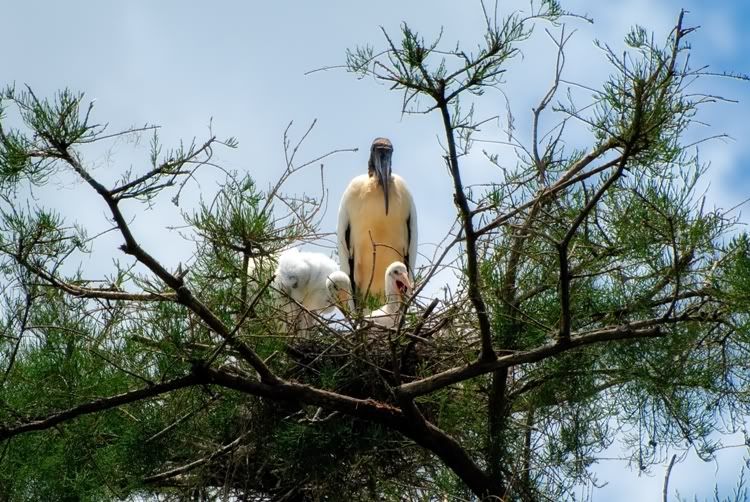
Endangered wood storks nesting in Fred George Basin, Spring 2009. Photo courtesy of Richard Leighton, Florida Nature Photography.

Wildwood Preservation Society is a non-profit 501(c)(4) project of the Advocacy Consortium for the Common Good. Click here to learn more.
"it's all connected"
Thursday, July 17, 2008
Wood storks in peril
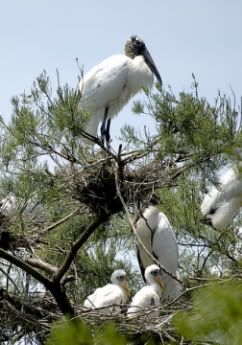
Endangered Wood Storks nesting in Fred George Basin, May 2008
Note: This has been an active wood stork mating season in Fred George Basin. Preliminary estimates for the Wildwood rookery suggest about a 75% nesting success rate. Unfortunately, historically large colonies in the south are being ravaged by drought and overdevelopment as evidenced by the article below. The protection of wood stork nesting and core foraging areas in places like Fred George Basin is more critical now than ever. Read on…
Wood storks in peril
By Jenna Buzzacco
Naples News
July 10, 2008
Here’s one first no one is celebrating: For the first time in 50 years, wood storks have not returned to nest at Corkscrew Swamp for two consecutive years.
And with the potential for a third year looming on the horizon, wood stork experts are concerned about what could happen to the species.
“Wood storks are an indicator,” said Jason Lauritsen, a science coordinator at the Audubon Corkscrew Swamp Sanctuary. “The wood stork is the gauge. The wood stork lets us know what’s going on out there.”
What’s going on out there is a drought. And that, paired with continuing development throughout South Florida, could be the reason the storks aren’t returning to nest.
The water levels in 2007 were about 20 inches below average. Last year was the first time since 2002 that no nests or fledglings were reported. In 2002, according to an annual rainfall report, water levels were less than five inches below average.
There’s a correlation between rainfall and the number of wood storks nesting each year, Lauritsen said. That’s because the birds depend on having just the right amount of water in marshes, cypress sloughs and pine flatwoods to survive.
Wood stork nesting season can start as early as November, Lauritsen said. In Southwest Florida, though, wood storks have typically begun nesting in January or February.
About 15 to 18 inches of water is deep enough to provide enough small fish for adults and their chicks. It’s also shallow enough for the adults to easily wade through to catch food.
But walk down Corkscrew’s boardwalk and you’ll find that there’s not 15 inches of water in sight. The lettuce lakes are empty. And with only about an inch of water in the vast open space, it’s hard to even picture it as a swamp.
It’s not just Southwest Florida that’s seeing a decrease in wood storks, though. Bill Brooks, a wildlife biologist for the U.S. Fish and Wildlife Service in Jacksonville, said nesting appears to be down throughout Central and Southwest Florida.
“It’s related to the drought that we have been going through, so conditions won’t be right (in some areas),” Brooks said. “But as you move further north, the nesting conditions must be better. There is nesting going on.”
Nesting is happening in northern Florida, Georgia and South Carolina. Brooks said Georgia saw a record number of nests this spring. According to the Georgia Department of Natural Resources, birds were found nesting in 24 colonies in 14 Georgia counties, resulting in about 2,225 nests.
In 2006, a record for wood stork nests was set in Georgia when about 1,900 were found.
Lauritsen said Corkscrew saw about 1,550 birds fledge — or leave the nest — in 2006. About 800 nests were reported that year.
“Southwest Florida has historically been the most important (place), but it has also been the most unstable,” Lauritsen said. “There’s more and more (wood storks) in Georgia and South Carolina. It is possible that those trends will stabilize. We lose them, but at least there are still storks.”
Losing the wood stork is a risk. The stork was listed on the federal endangered species list in 1984, but there have been efforts to downgrade the species to threatened. Brooks said a five-year study showed the birds could be considered threatened, not endangered, but said that could change since nesting numbers are lower than expected.
Not only does losing the wood stork mean losing an important gauge on what’s going on in the environment, Lauritsen said it also means people will lose an “amazing” creature.
“It’s amazing,” he said as he talked about the birds learning how to fly. “It’s awesome. They’re reckless acrobats.”
It’s too early to tell whether the birds will be back to nest next year, Lauritsen said. But he also said people shouldn’t depend solely on the weather to bring the birds back.
“If we’re betting on recovering the wood stork and betting on the weather ... (the weather) is something we can’t control,” he said.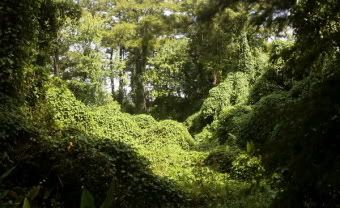
Due to dryness in the past year, moon vine has taken over much of the lettuce lake area of Corkscrew Swamp Sanctuary, a habitat that is normally comfortable nesting ground for wood storks. The species became listed as endangered in 1984, but has generally thrived in southwest Florida until the drought conditions of the last two years. According to biologist Jason Lauritsen, "Southwest Florida has historically been the most important region for wood storks in biologists' minds, but also the most vulnerable due to land use changes."
RELATED INFO
Survival Story- Wood Storks Thriving in Georgia
The Brunswick News
July 9, 2008
Endangered wood storks double number of nests
Florida The Times-Union
July 2, 2008
A rare bird all but vanishes from Everglades
Miami Herald
July 5, 2008

Wildwood Preservation Society is a non-profit 501(c)(4) project of the Advocacy Consortium for the Common Good. Click here to learn more.
"it's all connected"









